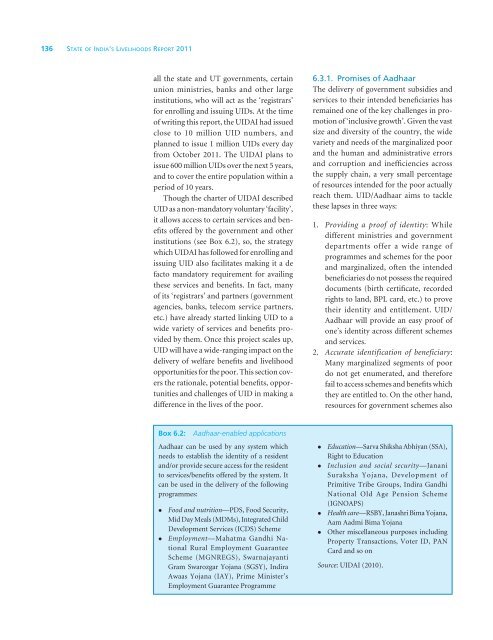SOIL Report 2011 - ACCESS Development Services
SOIL Report 2011 - ACCESS Development Services
SOIL Report 2011 - ACCESS Development Services
- No tags were found...
You also want an ePaper? Increase the reach of your titles
YUMPU automatically turns print PDFs into web optimized ePapers that Google loves.
136 State of India’s Livelihoods <strong>Report</strong> <strong>2011</strong>all the state and UT governments, certainunion ministries, banks and other largeinstitutions, who will act as the ‘registrars’for enrolling and issuing UIDs. At the timeof writing this report, the UIDAI had issuedclose to 10 million UID numbers, andplanned to issue 1 million UIDs every dayfrom October <strong>2011</strong>. The UIDAI plans toissue 600 million UIDs over the next 5 years,and to cover the entire population within aperiod of 10 years.Though the charter of UIDAI describedUID as a non-mandatory voluntary ‘facility’,it allows access to certain services and benefitsoffered by the government and otherinstitutions (see Box 6.2), so, the strategywhich UIDAI has followed for enrolling andissuing UID also facilitates making it a defacto mandatory requirement for availingthese services and benefits. In fact, manyof its ‘registrars’ and partners (governmentagencies, banks, telecom service partners,etc.) have already started linking UID to awide variety of services and benefits providedby them. Once this project scales up,UID will have a wide-ranging impact on thedelivery of welfare benefits and livelihoodopportunities for the poor. This section coversthe rationale, potential benefits, opportunitiesand challenges of UID in making adifference in the lives of the poor.6.3.1. Promises of AadhaarThe delivery of government subsidies andservices to their intended beneficiaries hasremained one of the key challenges in promotionof ‘inclusive growth’. Given the vastsize and diversity of the country, the widevariety and needs of the marginalized poorand the human and administrative errorsand corruption and inefficiencies acrossthe supply chain, a very small percentageof resources intended for the poor actuallyreach them. UID/Aadhaar aims to tacklethese lapses in three ways:1. Providing a proof of identity: Whiledifferent ministries and governmentdepartments offer a wide range ofprogrammes and schemes for the poorand marginalized, often the intendedbeneficiaries do not possess the requireddocuments (birth certificate, recordedrights to land, BPL card, etc.) to provetheir identity and entitlement. UID/Aadhaar will provide an easy proof ofone’s identity across different schemesand services.2. Accurate identification of beneficiary:Many marginalized segments of poordo not get enumerated, and thereforefail to access schemes and benefits whichthey are entitled to. On the other hand,resources for government schemes alsoBox 6.2: Aadhaar-enabled applicationsAadhaar can be used by any system whichneeds to establish the identity of a residentand/or provide secure access for the residentto services/benefits offered by the system. Itcan be used in the delivery of the followingprogrammes:• Food and nutrition—PDS, Food Security,Mid Day Meals (MDMs), Integrated Child<strong>Development</strong> <strong>Services</strong> (ICDS) Scheme• Employment—Mahatma Gandhi NationalRural Employment GuaranteeScheme (MGNREGS), SwarnajayantiGram Swarozgar Yojana (SGSY), IndiraAwaas Yojana (IAY), Prime Minister’sEmployment Guarantee Programme• Education—Sarva Shiksha Abhiyan (SSA),Right to Education• Inclusion and social security—JananiSuraksha Yojana, <strong>Development</strong> ofPrimitive Tribe Groups, Indira GandhiNational Old Age Pension Scheme(IGNOAPS)• Health care—RSBY, Janashri Bima Yojana,Aam Aadmi Bima Yojana• Other miscellaneous purposes includingProperty Transactions, Voter ID, PANCard and so onSource: UIDAI (2010).














